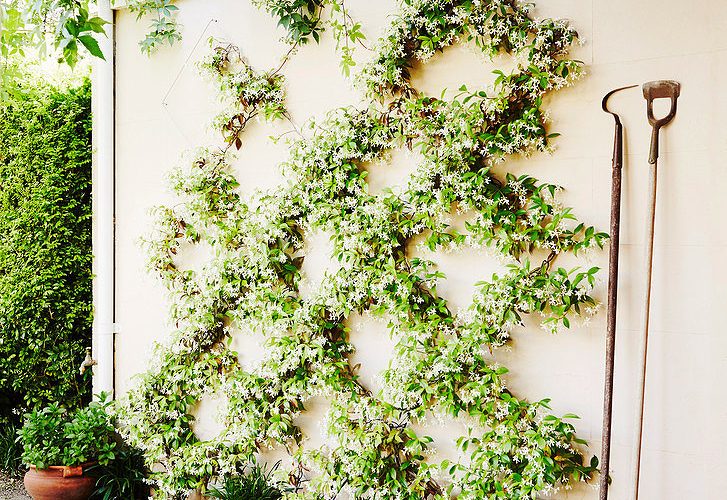Climbing plants are the framework of the garden. They disguise unattractive walls and fences, can be used to cover pergolas (providing shade faster than any tree will grow) and cover landscaping features in the garden such as pyramids, providing focal points. They can be extremely useful in a small garden to create small areas of privacy from prying neighbours by training them over vertical trellising.
There are so many climbers and creepers to choose from, it is almost impossible to pick one. We’ve chosen three old favourites that never disappoint:
Trachelospermum jasminoides (Star Jasmine)
An evergreen, vigorous climber that bears pure white, star-shaped flowers all summer on twining stems. Excellent in a large container or in open ground, it is happiest in full sun but can tolerate afternoon shade. Make sure it is planted in well-drained soil and feed regularly from the beginning of spring to ensure that beautiful mass of fragrant white flowers. Star Jasmine can tolerate cold winter temperatures but is not frost hardy.
Petrea volubilis (Purple Wreath)
An old-fashioned favourite that is once again attracting attention from growers is this beautiful climber with its long drooping sprays of violet-blue star-shaped flowers in spring and early summer. Petrea prefers a tropical to sub-tropical climate but can thrive even in the hot, dry summers of the Western Cape, providing it has warmth, sun, enough water, a slightly acidic soil, shelter from very strong wind and regular feeding. In other words, try and cultivate a microclimate for this climber and you will be richly rewarded! Petrea does need to be trained over a support structure such as a pergola as it can become quite top heavy.
Senecio tamoides (Canary Creeper)
Another old-fashioned favourite making a comeback is the striking bright yellow Canary Creeper. Most people will recognise the daisy-like flowers that cover this hardy climber in a blaze of glory from late summer and late into autumn. This easy climber is evergreen with shiny succulent-like foliage and is a fast grower, great for gardeners who are establishing a new garden. While Senecio prefers full sun, it is quite happy in morning sun with some dappled shade. Its flowers are highly attractive to bees and butterflies, so it’s guaranteed to bring the pollinators into your garden. Provide a trellis if you wish to use it to cover a wall or train it over a pergola or archway. Plant your Canary Creeper in well- composted soil with good drainage. Be careful not to overwater as this species is semi-succulent and can tolerate quite long periods of drought. Don’t be afraid of cutting this climber back at the end of summer – it will catch-up very quickly and reward you with even more flowers the following season.
ALSO SEE HOW TO GROW MUSHROOMS AT HOME

